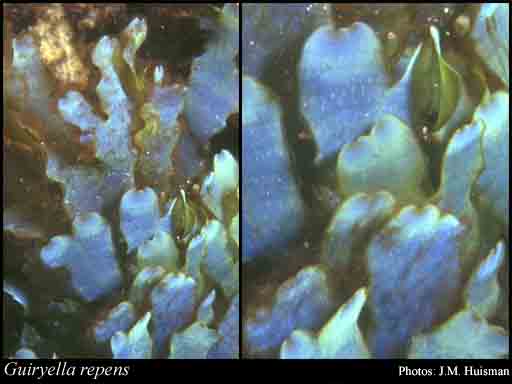- Reference
- Phycologia 129-133, figs 1-20 (1992)
- Conservation Code
- Not threatened
- Naturalised Status
- Native to Western Australia
- Name Status
- Current

Scientific Description
Habit and structure. Thallus erect from a prostrate base, dark red-brown, 2–10 mm high, much branched irregularly radially with subdichotomous 4–6-celled laterals from most cells and indeterminate axes every 2–5 cells, mature axes more or less alternately distichous, apices overtopped by laterals. Attachment of prostrate filaments by unicellular rhizoids with digitate haptera; epiphytic on Dictyotales. Structure. Apical cells 10–16 µm in diameter and L/D 2–6, lower cells of determinate laterals 10–30 µm in diameter and L/D 6–10, cells of indeterminate laterals and axes 45–75 µm in diameter and L/D 2–6; prostrate axes 50–180 µm in diameter, cells L/D 3–4. Cells multinucleate; rhodoplasts discoid to elongate.
Reproduction. Propagules 2-celled, ovoid, 100–140 µm in diameter with the basal cell trapeziform, terminating short indeterminate branches with a 2-celled stalk, with the upper propagule cell much larger than the lower. Gametophytes dioecious. Procarps borne on the subapical cell of short axes, with 3 periaxial cells, one acting as the supporting cell and bearing a carpogonial branch and a sterile cell, and a larger hypogenous cell. Post-fertilization the supporting cell and adjacent periaxial cell cut off auxiliary cells, with 2 connecting cells from the carpogonium; carpogonial branch cells fuse and later degenerate. Each auxiliary cell produces a gonimolobe, 200–300 µm across, of ovoid carposporangia 35–50 µm in diameter. Sterile procarp cells (apical, sterile periaxial and supporting sterile cells) each divide once to produce short 2-celled branches; no other involucral branches occur. Spermatangial heads are ovoid, 30–50 µm in diameter, on cells of laterals, with 2–3 axial cells bearing whorls of cells with outer spermatangia. Tetrasporangia occur on the upper ends of cells of laterals, subspherical with thick wall sheaths, 60–80 µm in diameter, tetrahedrally divided.
Distribution.Houtman Abrolhos and Rottnest I., W. Aust., and Tiparra Reef to Port Noarlunga, S. Aust.
[After Womersley, Mar. Benthic Fl. Southern Australia IIIC: 312–313 (1998)]
Distribution
- IBRA Regions
- Geraldton Sandplains.
- IBRA Subregions
- Geraldton Hills.
- IMCRA Regions
- Leeuwin-Naturaliste.
- Local Government Areas (LGAs)
- Cockburn, Greater Geraldton, Rockingham.